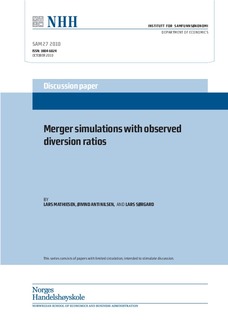| dc.contributor.author | Mathiesen, Lars | |
| dc.contributor.author | Nilsen, Øivind Anti | |
| dc.contributor.author | Sørgard, Lars | |
| dc.date.accessioned | 2011-02-17T12:42:52Z | |
| dc.date.available | 2011-02-17T12:42:52Z | |
| dc.date.issued | 2010-10 | |
| dc.identifier.issn | 0804-6824 | |
| dc.identifier.uri | http://hdl.handle.net/11250/163328 | |
| dc.description.abstract | A common approach to merger simulations used in antitrust cases is to calibrate demand
from market shares and a few additional parameters. When the products involved in the
merger case are differentiated along several dimensions, the resulting diversion ratios may
be very different from those based upon market shares. This again may affect the predicted
post-merger price effects. This article shows how merger simulation can be improved by
using observed diversion ratios. To illustrate the effects of this approach we use diversion
ratios from a local grocery market in Norway. In this case diversions from the acquired to
the acquiring stores were considerably smaller than suggested by market shares, and the
predicted average price increase from the acquisition was 40 % lower using this model
rather than a model based upon market shares. This analysis also suggests that even a subset
of observed diversion ratios may significantly change the prediction from a merger
simulation based upon market shares. | en |
| dc.language.iso | eng | en |
| dc.publisher | Norwegian School of Economics and Business Administration. Department of Economics | en |
| dc.relation.ispartofseries | Discussion paper | en |
| dc.relation.ispartofseries | 2010:27 | en |
| dc.subject | merger simulation | en |
| dc.subject | diversion ratio | en |
| dc.subject | asymmetric differantiation | en |
| dc.subject | merger policy | en |
| dc.title | Merger simulations with observed diversion ratios | en |
| dc.type | Working paper | en |
| dc.subject.nsi | VDP::Samfunnsvitenskap: 200::Økonomi: 210::Bedriftsøkonomi: 213 | en |
